Impact of Spatial Configuration on Promoting Lifelong Learning Development in Pathum Thani, Thailand
Abstract
1. Introduction
2. Methodology
2.1. Site Selection
2.2. Questionnaire
2.3. GIS Modeling
2.4. Data Analysis
3. Results
3.1. Sample Description
3.2. Urban Centrality
3.3. Urban Centrality, Accessibility and Participation in Learning Activities
4. Discussion
5. Conclusions
Author Contributions
Funding
Institutional Review Board Statement
Informed Consent Statement
Data Availability Statement
Conflicts of Interest
References
- Zhou, Y.X.; Zhang, L.; Wu, Y. Study of China’s urban centrality hierarchy. Reg. Areal Res. Dev. 2001, 20, 1–5. [Google Scholar]
- Shim, G.-E.; Rhee, S.-M.; Ahn, K.-H.; Chung, S.-B. The relationship between the characteristics of transportation energy consumption and urban form. Ann. Reg. Sci. 2006, 40, 351–367. [Google Scholar] [CrossRef]
- Irwan, M.D.; Hughes, H.L. Centrality and the Structure of Urban Interaction: Measures, Concepts, and Applications. Soc. Forces 1992, 71, 17–51. [Google Scholar] [CrossRef]
- Miranda, E.; E Silva, J.B.; Da Costa, A.R. Emergence and Structure of Urban Centralities in a Medium-Sized Historic City. SAGE Open 2020, 10, 2158244020930002. [Google Scholar] [CrossRef]
- Aguilera, A. Growth in Commuting Distances in French Polycentric Metropolitan Areas: Paris, Lyon and Marseille. Urban Stud. 2005, 42, 1537–1547. [Google Scholar] [CrossRef]
- Anas, A.; Arnott, R.; Small, K.A. Urban Spatial Structure. J. Econ. Lit. 1998, 36, 1426–1464. [Google Scholar]
- Galster, G.; Hanson, R.; Ratcliffe, M.R.; Wolman, H.; Coleman, S.; Freihage, J. Wrestling Sprawl to the Ground: Defining and measuring an elusive concept. Hous. Policy Debate 2001, 12, 681–717. [Google Scholar] [CrossRef]
- United Nations. Urbanization: Expanding Opportunities, but Deeper Divides. 2020. Available online: https://www.un.org/development/desa/en/news/social/urbanization-expanding-opportunities-but-deeper-divides.html (accessed on 1 April 2023).
- Ha, N.M.; Le, N.D.; Trung-Kien, P. The impact of urbanization on poverty reduction: An evidence from Vietnam. Cogent Econ. Financ. 2021, 9, 1918838. [Google Scholar] [CrossRef]
- Arouri, M.; Ben Youssef, A.; Nguyen, C. Does urbanization reduce rural poverty? Evidence from Vietnam. Econ. Model. 2017, 60, 53–270. [Google Scholar] [CrossRef]
- Qi, W.; Liu, S.; Zhao, M.; Liu, Z. China’s different spatial patterns of population growth based on the “Hu Line”. J. Geogr. Sci. 2016, 26, 1611–1625. [Google Scholar] [CrossRef]
- Chen, D.; Zhang, Y.; Yao, Y.; Hong, Y.; Guan, Q.; Tu, W. Exploring the spatial differentiation of urbanization on two sides of the Hu Huanyong Line—Based on nighttime light data and cellular automata. Appl. Geogr. 2019, 112, 102081. [Google Scholar] [CrossRef]
- Liddle, B. Urbanization and Inequality/Poverty. Urban Sci. 2017, 1, 35. [Google Scholar] [CrossRef]
- Chen, G.; Glasmeier, A.K.; Zhang, M.; Shao, Y. Urbanization and Income Inequality in Post-Reform China: A Causal Analysis Based on Time Series Data. PLoS ONE 2016, 11, e0158826. [Google Scholar] [CrossRef]
- Iamtrakul, P.; Kardi, T.; Jian, G.; Kazunori, H. Interaction of activity involvement and recreational location selection behavior in Lowland City: A case study of public parks in Saga City, Japan. J. Zhejiang Univ. A 2005, 6, 900–906. [Google Scholar] [CrossRef]
- Xu, G.; Jiao, L.; Liu, J.; Shi, Z.; Zeng, C.; Liu, Y. Understanding urban expansion combining macro patterns and micro dynamics in three Southeast Asian megacities. Sci. Total Environ. 2019, 660, 375–383. [Google Scholar] [CrossRef]
- Iamtrakul, P.; Chayphong, S. The perception of Pathumthani residents toward its environmental quality, suburban area of Thailand. Geogr. Pannonica 2021, 25, 136–148. [Google Scholar] [CrossRef]
- Nakagawa, S. Residents in a suburban area of Bangkok Metropolis; Classification by migratory and social characteristics. Reg. Views 1997, 10, 45–59. [Google Scholar]
- Padon, A.; Iamtrakul, P.; Thanapirom, C. The Study of Urbanization Effect on the Land Use Changes and Urban Infrastructures Development in the Metropolitan Areas, Thailand. IOP Conf. Ser. Earth Environ. Sci. 2021, 738, 012077. [Google Scholar] [CrossRef]
- Kearns, P. Learning cities as healthy green cities: Building sustainable opportunity cities. Aust. J. Adult Learn. 2012, 52, 368–391. [Google Scholar]
- Iamtrakul, P.; Chayphong, S.; Kantavat, P.; Hayashi, Y.; Kijsirikul, B.; Iwahori, Y. Exploring the Spatial Effects of Built Environment on Quality of Life Related Transportation by Integrating GIS and Deep Learning Approaches. Sustainability 2023, 15, 2785. [Google Scholar] [CrossRef]
- UNESCO Institute for Lifelong Learning. Inclusive Lifelong Learning in Cities: Policies and Practices for Vulnerable Groups. 2021. Available online: https://unesdoc.unesco.org/ark:/48223/pf0000379538 (accessed on 15 April 2023).
- OECD. CASE Study: Lifelong Learning in Korea. 2019. Available online: https://www.oecd-ilibrary.org/sites/cd2b486a-en/index.html?itemId=/content/component/cd2b486a-en (accessed on 25 March 2023).
- Atchoarena, D.; Howells, A. Advancing Learning Cities: Lifelong Learning and the Creation of a Learning Society. In Powering a Learning Society during an Age of Disruption; Education in the Asia-Pacific Region: Issues, Concerns and Prospects, 58; Ra, S., Jagannathan, S., Maclean, R., Eds.; Springer: Singapore, 2021; pp. 165–180. [Google Scholar] [CrossRef]
- Longworth, N. The Local and Regional Dimension of Lifelong Learning: Creating Learning Cities, Towns and Regions, a European Policy Paper from the TELS Project; DG Education and Culture: Brussels, Belgium, 2001. [Google Scholar]
- UNESCO Institute for Lifelong Learning. Learning Cities and the SDGs: A Guide to Action. 2017. Available online: https://www.local2030.org/library/403/Learning-Cities-and-the-SDGs-A-Guide-to-Action.pdf (accessed on 15 April 2023).
- UIL. Conceptual Evolution and Policy Developments in Lifelong Learning; UIL: Hamburg, Germany, 2011. [Google Scholar]
- Khurana, A. Converting physical spaces into learning spaces: Integrating universal design and universal design for learning. Front. Educ. 2022, 7, 965818. [Google Scholar] [CrossRef]
- Németh, B.; Issa, O.; Diba, F.; Tuckett, A. Learning cities and learning communities: Analyzing contextual factors and their impacts on adult and lifelong learning in urban settings. Andragoske Stud. 2020, 2020, 17–52. [Google Scholar] [CrossRef]
- Iamtrakul, P.; Chayphong, S.; Lo, A.Y.W. Exploring the Contribution of Social and Economic Status Factors (SES) to the Development of Learning Cities (LC). Sustainability 2022, 14, 12685. [Google Scholar] [CrossRef]
- Casanova, D.; Huet, I.; Garcia, F. The Experience of Co-Designing a Learning Space with Teachers and Students. Educ. Sci. 2023, 13, 103. [Google Scholar] [CrossRef]
- Mei, B.; May, L. Reflective renovation: Insights from a collaborative and active learning space project evaluation. Australas. J. Educ. Technol. 2018, 34, 4476. [Google Scholar] [CrossRef]
- Kersh, N. Rethinking the learning space at work and beyond: The achievement of agency across the boundaries of work-related spaces and environments. Int. Rev. Educ. 2015, 61, 835–851. [Google Scholar] [CrossRef]
- Azeiteiro, U.M.; Akerman, M.; Leal Filho, W.; Setti, A.F.F.; Brandli, L.L. (Eds.) Lifelong Learning and Education in Healthy and Sustainable Cities; World Sustainability Series; Springer: Berlin/Heidelberg, Germany, 2018. [Google Scholar] [CrossRef]
- Iamtrakul, P.; Padon, A.; Klaylee, J. Analysis of Urban Sprawl and Growth Pattern Using Geospatial Technologies in Megacity, Bangkok, Thailand; Lecture Notes on Data Eng; Sprinegering and Communications Technologies; Springer: Singapore, 2022; Volume 143, pp. 109–123. [Google Scholar] [CrossRef]
- Iamtrakul, P.; Chayphong, S. Factors affecting the development of a healthy city in Suburban areas, Thailand. J. Urban Manag. 2023; in press. [Google Scholar] [CrossRef]
- Iamtrakul, P.; Raungratanaamporn, I.; Klaylee, J. The impact of urban development on social capital in urban fringe area of Bangkok, Thailand. Lowl. Technol. Int. 2018, 20, 331–340. [Google Scholar]
- Official Statistics Registration Systems. Population Statistics. 2021. Available online: https://statboradopagoth/new_stat/webPage/statByYearphp (accessed on 25 March 2023).
- Krejcie, R.V.; Morgan, D.W. Determining Sample Size for Research Activities. Educ. Psychol. Meas. 1970, 30, 607–610. [Google Scholar] [CrossRef]
- Poorthuis, A.; Zook, M. Making Big Data Small: Strategies to Expand Urban and Geographical Research Using Social Media. J. Urban Technol. 2017, 24, 115–135. [Google Scholar] [CrossRef]
- Haider, M.A.; Iamtrakul, P. Analyzing Street Crime Hotspots and Their Associated Factors in Chittagong City, Bangladesh. Sustainability 2022, 14, 9322. [Google Scholar] [CrossRef]
- Walters, S. Researching Indicators for a Learning Region. 2006. Available online: http://wwwleedsacuk/educol/documents/155405htm (accessed on 31 March 2023).
- Fauzi, I.; Khusuma, I.H.S. Teachers’ Elementary School in Online Learning of COVID-19 Pandemic Conditions. J. IQRA 2020, 5, 58–70. [Google Scholar] [CrossRef]
- Kasanobu, K.; Varameth, V.; Carlos, L.; Ana, M.; Rolf, M.; Yoshitsugu, H. Impact of Decentralization and Rail Network Extension on Future Traffic in The Bangkok Metropolitan Region. Sustainability 2021, 13, 13196. [Google Scholar] [CrossRef]
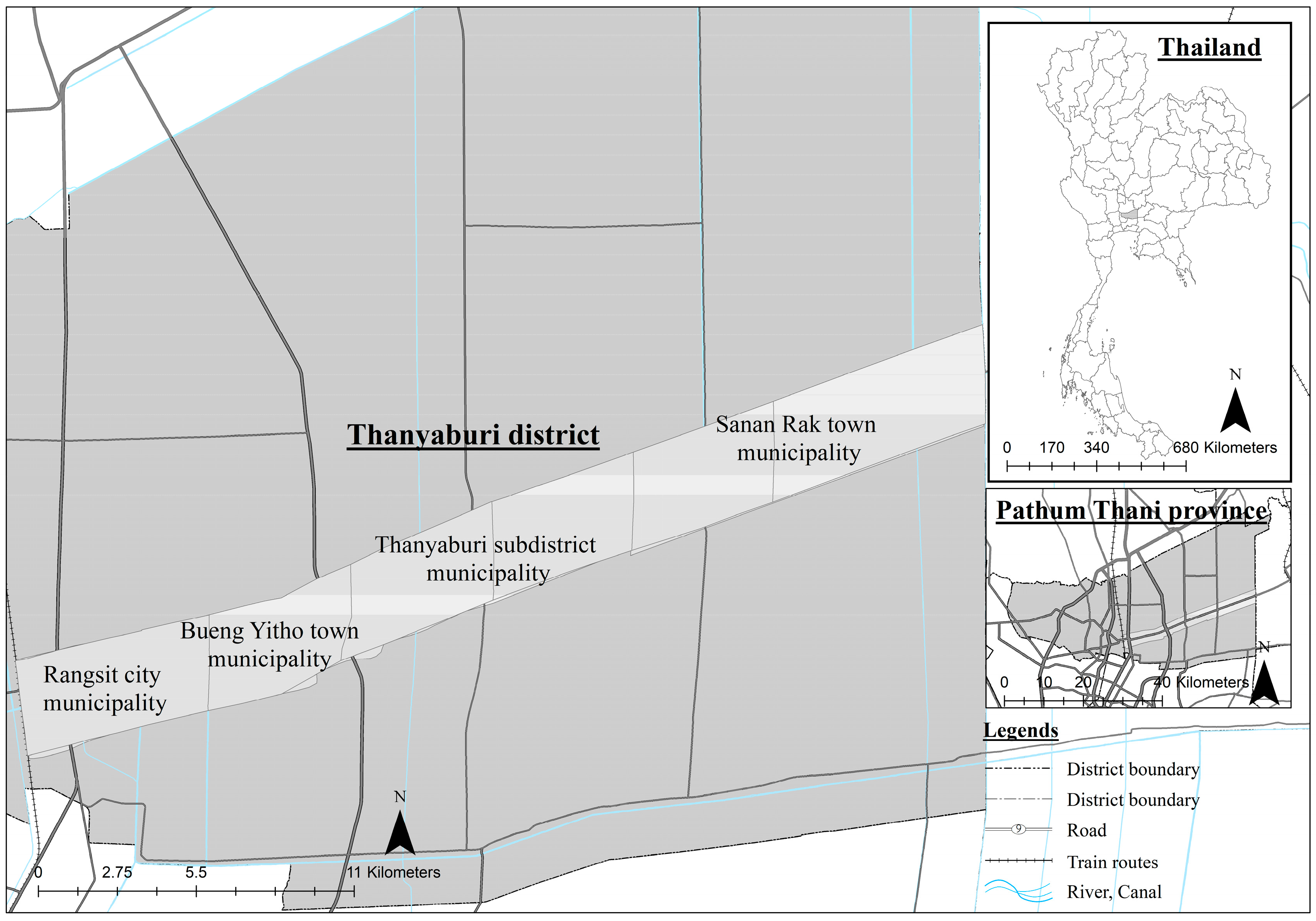
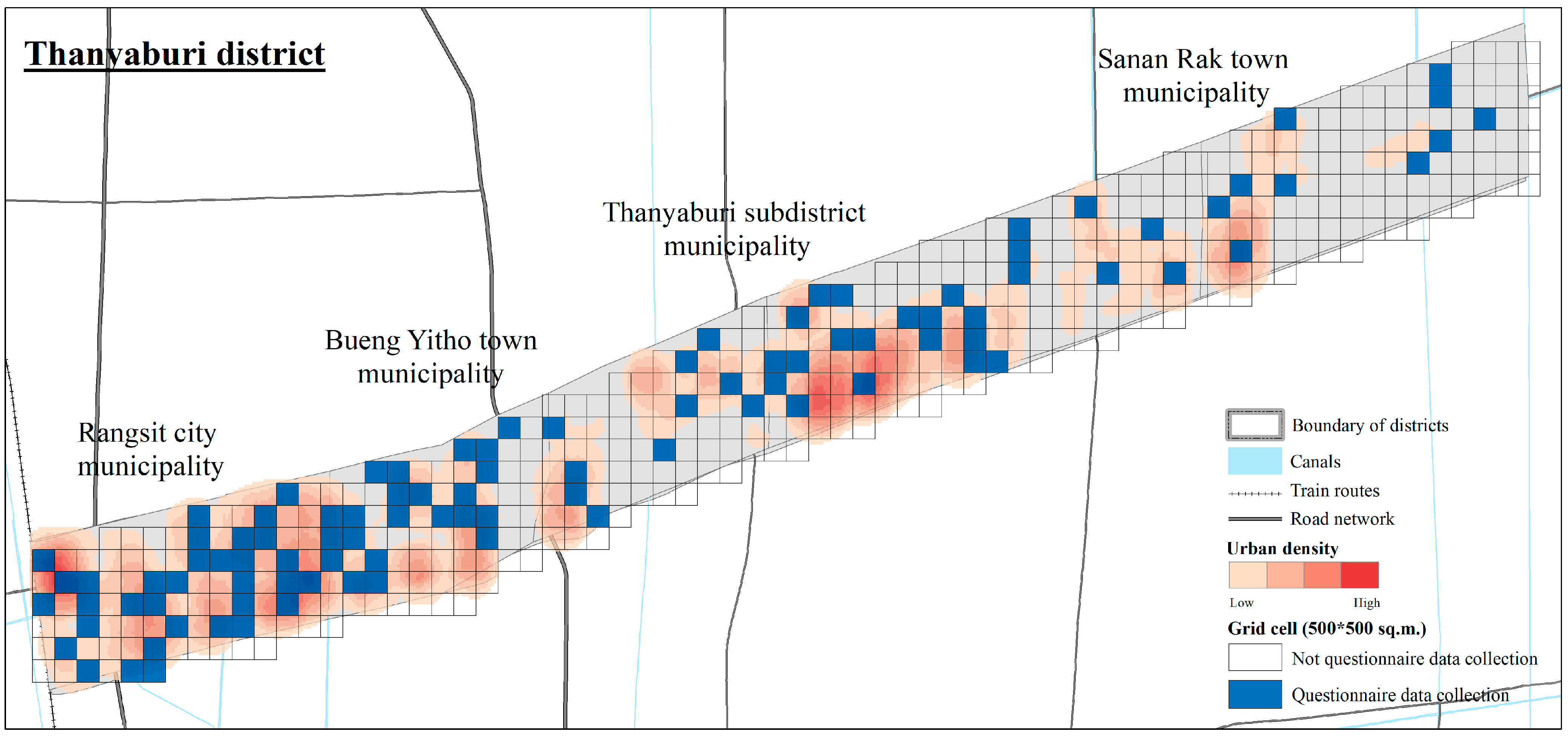
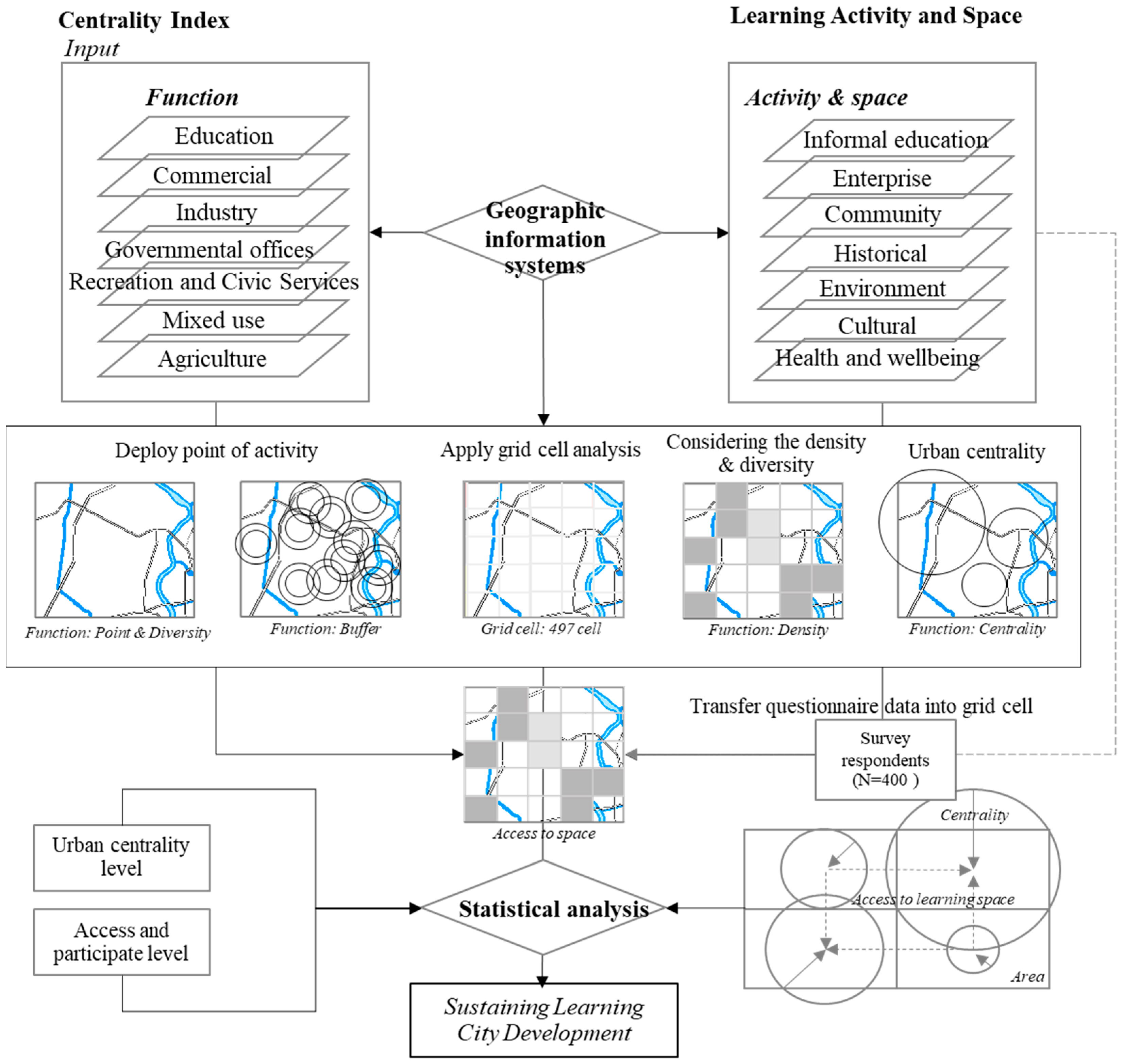


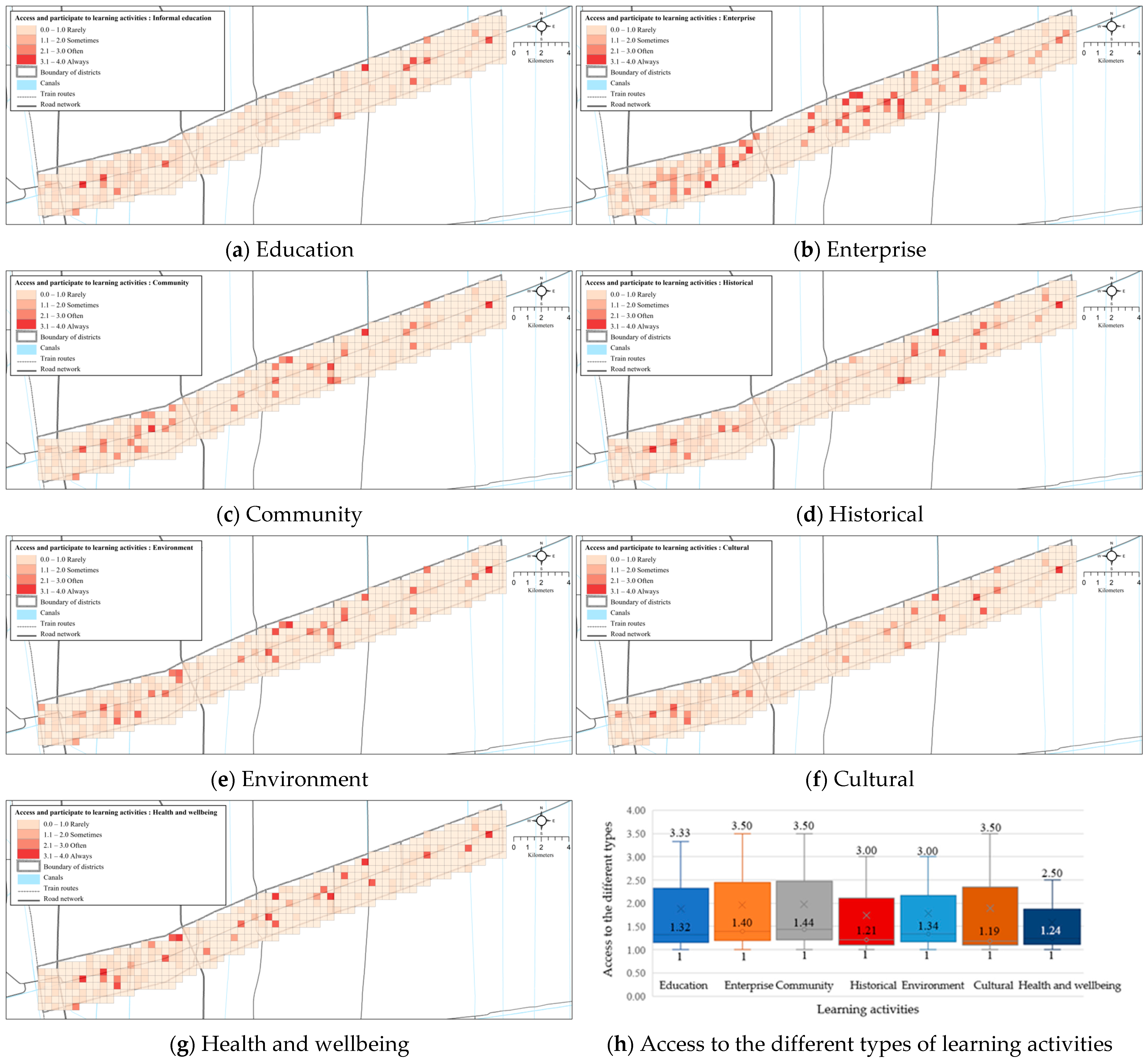
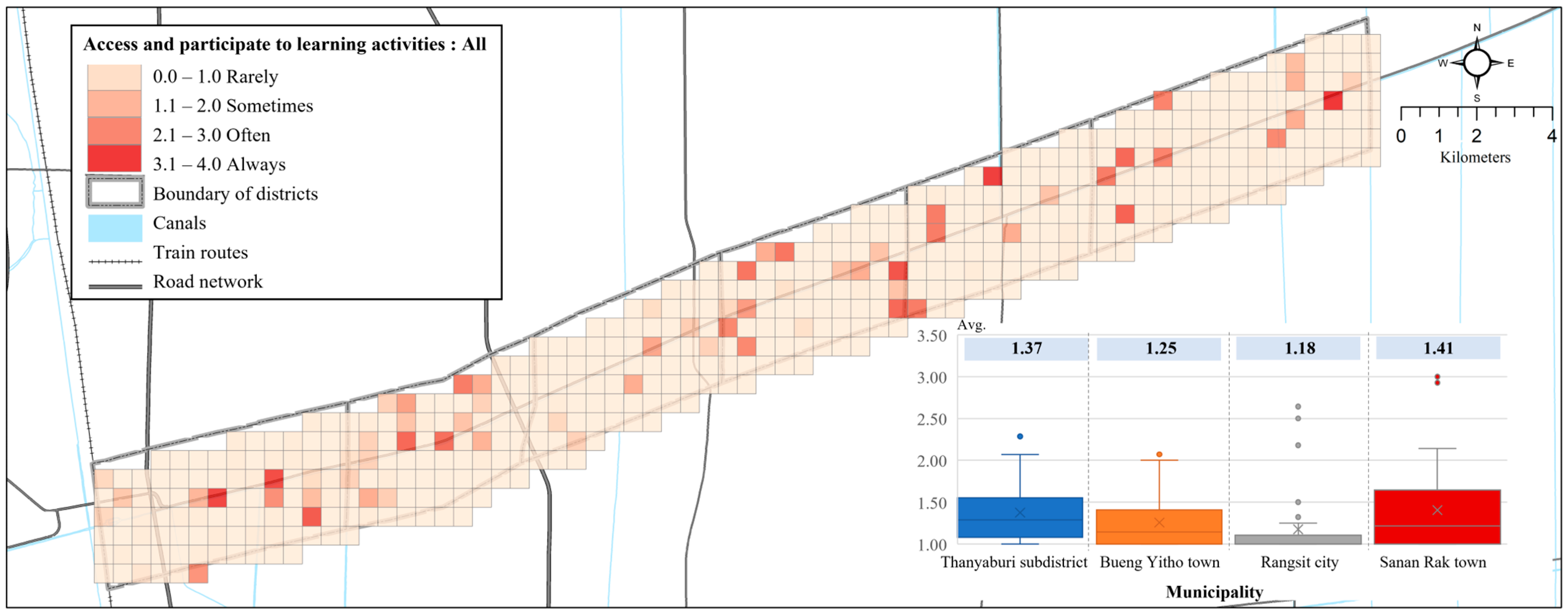
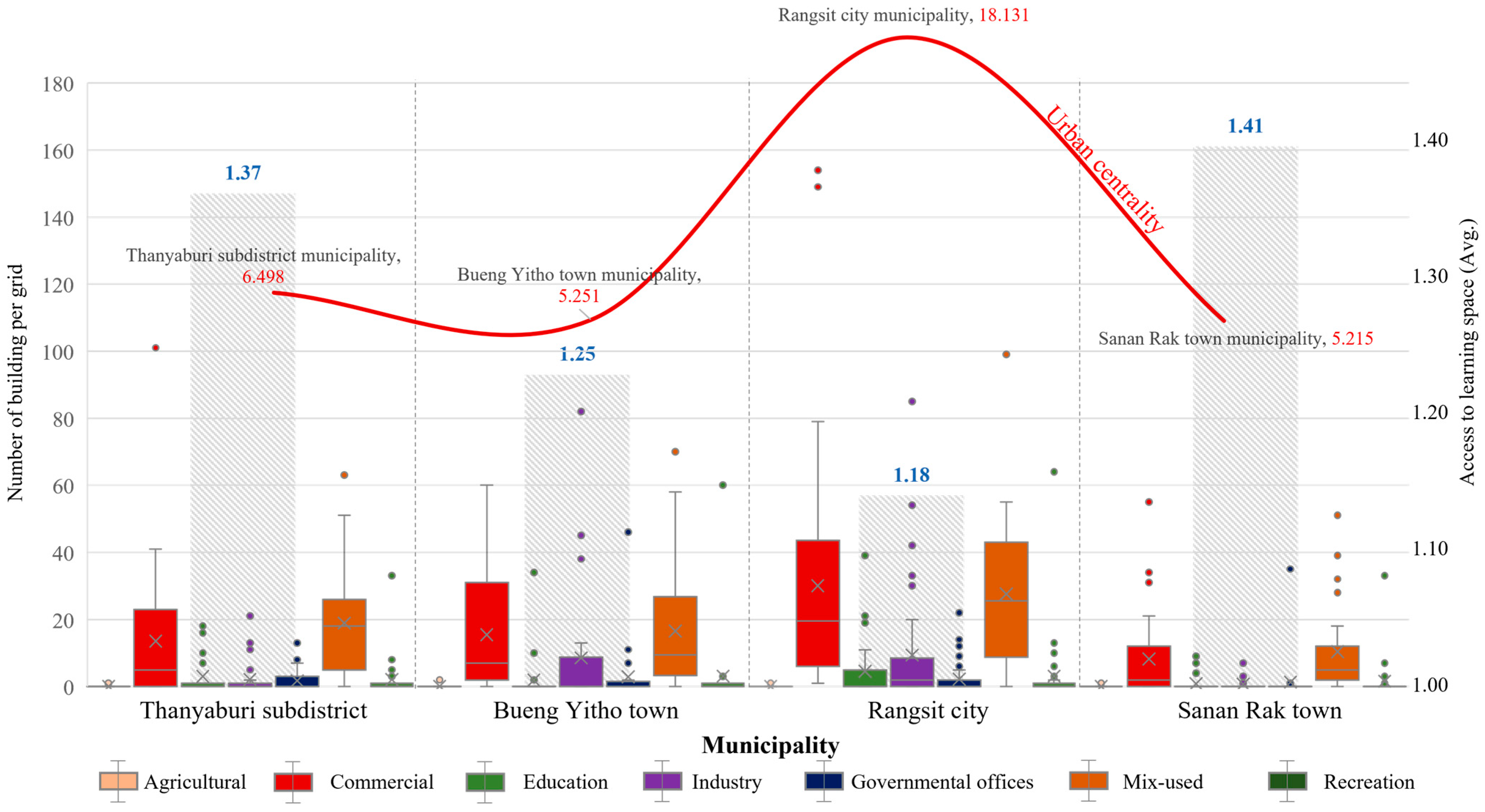

| Variables/Source | Attributes | Unit | Municipality | District | Province | |||
|---|---|---|---|---|---|---|---|---|
| 1 | 2 | 3 | 4 | 5 | 6 | |||
| Gender (registered population) /Municipality office | Male | Person | 39,158 | 15,385 | 30,546 | 15,444 | 100,533 | 568,877 |
| Female | Person | 45,386 | 18,329 | 33,879 | 17,334 | 114,928 | 632,655 | |
| Others | Person | - | - | - | - | - | - | |
| Gender/ Survey | Male | Person | 91 | 25 | 56 | 41 | 213 | 380 |
| Female | Person | 64 | 30 | 61 | 23 | 178 | 299 | |
| Other | Person | 4 | - | 2 | 3 | 9 | 21 | |
| Religion/ Survey | Buddhist | Person | 149 | 55 | 118 | 59 | 381 | 655 |
| Christian | Person | 5 | - | 1 | 3 | 9 | 18 | |
| Islam | Person | 3 | - | - | 5 | 8 | 24 | |
| Others | Person | 2 | - | - | - | 2 | 3 | |
| Marital status/ Survey | Married | Person | 68 | 31 | 90 | 25 | 214 | 326 |
| Single | Person | 28 | 7 | 15 | 17 | 67 | 138 | |
| Divorce | Person | 57 | 16 | 13 | 23 | 109 | 209 | |
| Others | Person | 6 | 1 | 1 | 2 | 10 | 27 | |
| Age structure/Municipality office | Population | Person | 84,544 | 33,714 | 64,425 | 32,778 | 215,461 | 1,201,532 |
| Number of households | Unit | 57,307 | 16,224 | 34,458 | 17,903 | 125,892 | 677,046 | |
| Family size | Person/Unit | 1.475 | 2.078 | 1.870 | 1.831 | 1.870 | 1.775 | |
| Male elderly | Person | 6037 | 2233 | 4373 | 2556 | 15,199 | 83,888 | |
| Female elderly | Person | 8725 | 3211 | 6004 | 3187 | 21,127 | 111,694 | |
| Elderly | Person | 14,762 | 5444 | 10,377 | 5743 | 36,326 | 195,582 | |
| %Elderly | Percent | 17.5 | 16.1 | 16.1 | 17.5 | 33.5 | 16.278 | |
| Age/ Survey | Less than 25 | Person | 41 | 4 | 1 | 16 | 62 | 118 |
| 25–35 | Person | 37 | 13 | 26 | 28 | 104 | 216 | |
| 36–45 | Person | 49 | 12 | 41 | 14 | 116 | 199 | |
| 46–55 | Person | 23 | 14 | 35 | 6 | 78 | 114 | |
| 56–65 | Person | 5 | 8 | 10 | 2 | 25 | 31 | |
| More than 65 | Person | 4 | 4 | 6 | 1 | 15 | 22 | |
| All | Average | 36 | 44 | 46 | 34 | 40 | 38 | |
| Variables/Source | Attributes | Unit | Municipality | District | Province | |||
|---|---|---|---|---|---|---|---|---|
| 1 | 2 | 3 | 4 | 5 | 6 | |||
| Workforce | Male workforce | Person | 26,146 | 10,490 | 20,113 | 10,100 | 40,703 | 381,998 |
| Female workforce | Person | 30,385 | 12,592 | 22,577 | 11,554 | 46,723 | 425,490 | |
| Total workforce | Person | 56,531 | 23,082 | 42,690 | 21,654 | 87,426 | 807,488 | |
| Income and expenditure/Municipality office | Income | THB/Month | 38,972.02 | 56,206.88 | 48,945.19 | 47,784.41 | 50,978.83 | 39,506.99 |
| Expenditure | THB/Month | 25,995.00 | 36,725.00 | 28,718.00 | 20,831.00 | 28,758.00 | 31,639.92 | |
| Higher education | Education | Person | 3126 | 1432 | 2466 | 2190 | 9214 | 52,922 |
| (Higher education: university) | ||||||||
| Education level/Survey | Primary school | Person | 6 | 8 | 8 | 0 | 16 | 22 |
| Junior high school | Person | 14 | 5 | 6 | 3 | 14 | 28 | |
| High school | Person | 35 | 8 | 22 | 11 | 41 | 76 | |
| Vocational college | Person | 27 | 8 | 22 | 13 | 43 | 70 | |
| Bachelor’s degree | Person | 58 | 25 | 59 | 30 | 114 | 172 | |
| Postgraduate | Person | 19 | 2 | 13 | 8 | 23 | 42 | |
| Occupation/Survey | Government | Person | 19 | 2 | 13 | 8 | 23 | 42 |
| Private agency | Person | 41 | 20 | 30 | 19 | 69 | 110 | |
| Students | Person | 28 | 3 | 1 | 10 | 14 | 42 | |
| Personal business | Person | 49 | 19 | 48 | 20 | 87 | 136 | |
| General employee | Person | 17 | 4 | 19 | 7 | 30 | 47 | |
| Farming/garden | Person | 0 | 0 | 5 | 1 | 6 | 6 | |
| Other | Person | 5 | 7 | 3 | 2 | 12 | 17 | |
| Average income, baht/Survey | Less than 5000 | Person | 10 | 6 | 4 | 2 | 12 | 22 |
| 5001–10,000 | Person | 17 | 4 | 7 | 4 | 15 | 32 | |
| 10,001–15,000 | Person | 31 | 9 | 19 | 21 | 49 | 80 | |
| 15,001–20,000 | Person | 39 | 9 | 26 | 12 | 47 | 86 | |
| 20,001–25,000 | Person | 14 | 8 | 32 | 8 | 48 | 62 | |
| 25,001–30,000 | Person | 21 | 5 | 15 | 4 | 24 | 45 | |
| 30,001–35,000 | Person | 13 | 11 | 13 | 4 | 28 | 41 | |
| 35,001–40,000 | Person | 6 | 3 | 0 | 5 | 8 | 14 | |
| More than 40,000 | Person | 8 | 0 | 3 | 7 | 10 | 18 | |
| Variables/Source | Attributes | Unit | Municipality | District | Province | |||
|---|---|---|---|---|---|---|---|---|
| 1 | 2 | 3 | 4 | 5 | 6 | |||
| Land classification/GIS data | Area boundary | sq.km | 21.77 | 16.42 | 33.93 | 42.81 | 115.17 | 1518.23 |
| Urbanized area | sq.km. | 16.82 | 8.89 | 16.59 | 8.03 | 49.86 | 462.77 | |
| Agricultural area | sq.km | 1.05 | 2.41 | 6.67 | 2.38 | 33.95 | 825.78 | |
| Water body | sq.km | 1.08 | 0.50 | 2.00 | 1.34 | 0.52 | 63.46 | |
| Miscellaneous | sq.km | 2.86 | 4.58 | 8.63 | 9.41 | 26.14 | 168.43 | |
| Number of buildings/GIS data | Resident | No. of unit | 31,704 | 13,490 | 29,485 | 16,708 | 91,387 | 622,474 |
| Commercial | No. of unit | 1816 | 860 | 1207 | 584 | 4467 | 33,093 | |
| Industry | No. of unit | 738 | 396 | 325 | 218 | 1677 | 23,300 | |
| Mixed use | No. of unit | 1864 | 725 | 1546 | 834 | 4969 | 32,949 | |
| Utility | No. of unit | 52 | 44 | 72 | 23 | 191 | 2079 | |
| Education | No. of unit | 337 | 109 | 228 | 147 | 821 | 6375 | |
| Religion | No. of unit | 115 | 115 | 147 | 118 | 495 | 9059 | |
| Government | No. of unit | 210 | 45 | 914 | 99 | 1268 | 4827 | |
| Recreation | No. of unit | 34 | 31 | 50 | 17 | 132 | 677 | |
| Agriculture | No. of unit | 1 | 2 | - | 17 | 20 | 1168 | |
| Residential period, years/Survey | 1–10 | Person | 98 | 24 | 31 | 39 | 94 | 192 |
| 11–20 | Person | 31 | 19 | 40 | 16 | 75 | 106 | |
| 21–30 | Person | 16 | 7 | 16 | 5 | 28 | 44 | |
| 31–40 | Person | 7 | 1 | 15 | 5 | 21 | 28 | |
| 41–50 | Person | 5 | 3 | 12 | 2 | 17 | 22 | |
| More than 51 | Person | 2 | 1 | 5 | 0 | 6 | 8 | |
Disclaimer/Publisher’s Note: The statements, opinions and data contained in all publications are solely those of the individual author(s) and contributor(s) and not of MDPI and/or the editor(s). MDPI and/or the editor(s) disclaim responsibility for any injury to people or property resulting from any ideas, methods, instructions or products referred to in the content. |
© 2023 by the authors. Licensee MDPI, Basel, Switzerland. This article is an open access article distributed under the terms and conditions of the Creative Commons Attribution (CC BY) license (https://creativecommons.org/licenses/by/4.0/).
Share and Cite
Iamtrakul, P.; Chayphong, S.; Crizzle, A.M. Impact of Spatial Configuration on Promoting Lifelong Learning Development in Pathum Thani, Thailand. Sustainability 2023, 15, 10791. https://doi.org/10.3390/su151410791
Iamtrakul P, Chayphong S, Crizzle AM. Impact of Spatial Configuration on Promoting Lifelong Learning Development in Pathum Thani, Thailand. Sustainability. 2023; 15(14):10791. https://doi.org/10.3390/su151410791
Chicago/Turabian StyleIamtrakul, Pawinee, Sararad Chayphong, and Alexander M. Crizzle. 2023. "Impact of Spatial Configuration on Promoting Lifelong Learning Development in Pathum Thani, Thailand" Sustainability 15, no. 14: 10791. https://doi.org/10.3390/su151410791
APA StyleIamtrakul, P., Chayphong, S., & Crizzle, A. M. (2023). Impact of Spatial Configuration on Promoting Lifelong Learning Development in Pathum Thani, Thailand. Sustainability, 15(14), 10791. https://doi.org/10.3390/su151410791








